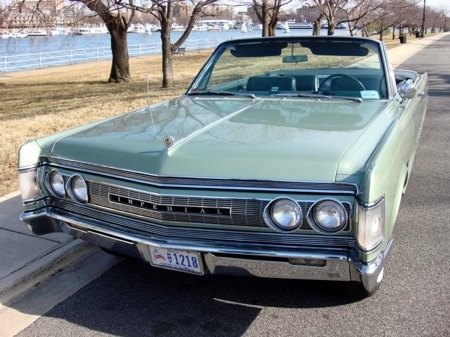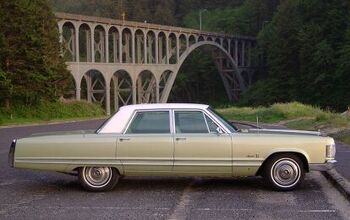Review: 1967 Chrysler Imperial

Not long ago, apropos of I don’t remember what, I posted on this site about a 1960 Imperial and its owner, Jim Byers. Byers had been an impressario of jazz for the Kennedy Center. I met him in the mid-90s while photographing his car. Byers saw my post on TTAC and emailed me. He’d replaced the ’60 with a ’67. Coincidentally, I had fled Boston’s snows for several weeks. We arranged to meet down by the Potomac so that I could test drive the ’67.
Of the top-of-the-line luxury cars of the ’50s and ’60s, Caddy had serious bling. Lincoln Continental had a dignified grace, and served as presidential limos to JFK and LBJ. The Imperial was too baroque for Washington, DC, but its elaborate elegance would have made it the perfect chariot for the Italian renaissance. Had Venice had roads instead of canals . . .
The 1960 Imperial’s luxuries are ample, starting with soft leather seats that hug you like a long lost friend. There’s a mirror inside the glove box for your lady, which folds down when she’s not using it, and a cigarette lighter on the right-hand door console for her smoking pleasure. Should you drive a bit too enthusiastically, she can grab the little security handle carved into the far right extremity of the dash.
For the rear passengers, a button slides either front bucket seat forward, ensuring graceful egress. All passengers are surrounded by a genuine walnut trim. The Imperial’s luxury aura takes a hit from the downmarket, colorless gray gauges and radio, reminiscent of those found on my parents’ 1970 Valiant, a near-stripper.
Like many classic cars, the Imperial comes with a history. In the 1940s, a small airplane embedded itself in the Empire State Building. The ’67’s first owner: Harvey B. Moyer, proprietor of the demolition company that had extricated plane from spire. Byers, owner number three, has added some of his own color to the Imperial’s history. For several years, he ran the Straight Eights, a DC area vintage car club for gays and lesbians.
To drive the Imperial is to feel elevated. President Obama must have felt something like this the first time he was chauffeured in that fortress of a Cadillac. President Obama, as you may know, drove a 340 hp Chrysler 300C until he was outed during the campaign, after castigating the D-3 for building “bigger, faster cars.” Poor Barack then felt obliged to purchase a Ford Escape hybrid, just like Hillary, and John Edwards, and Christopher Dodd (who had owned a Mustang). Hewing to political correctness can take the fun out of driving, but I digress.
Anyway, I set off at a leisurely pace from the Jefferson Memorial, along Potomac Park East. I pushed the Imperial ever so slightly as I rounded the corner that hooks back towards the Jefferson, just enough so she leaned like a yacht in a strong wind. The road was empty, so I floored her.
The Imperial weighs close to 5,000 lb. Despite my attempt to muster the Chrysler’s alleged 480 lb·ft of torque (at 2,800 rpm), she seemed in no hurry to reach 50 mph. I jerked the wheel to check the front end. After the helm returned to the straight ahead position, the big lady performed a little wiggle-woggle.
We cruised the Mall towards Air and Space, turning left onto fourth street, so that we could roll by I. M. Pei’s East Wing, my favorite Washington building, and on down Constitution Ave. I don’t need no stinkin’ SUV to sit high in this thing. I WAS high, looking out over all the people crowding the American History and Technology side of the Mall, hoping to see some Power, or maybe just a museum.
I was expecting them to notice ME, and this grand chariot. But no one seemed to notice, and then some stupid SUV actually cut in front of me. The whole family suddenly noticed that they’d just cut off President Holzman (that’s me, the first Jew to lead the Free World). They waved and smiled.
Besides the Imperial’s wonderfully floaty, boaty feel, and the effortlessly numb steering, this land yacht’s four disc brakes feel as competent as those on any contemporary appliance. The silky V8, with 72,000 original miles, feels like it could easily do another 72,000, and who knows, maybe another 72,000 after that, although I can’t help wondering if this beast felt far more puissant during the Nixon and Ford administrations than it does now.
My strongest impression of the Imperial came after I got back into my ’99 Accord LX with the 2.4-liter engine and the five speed stick. The Honda felt the way my brother-in-law’s Audi TT had felt just days earlier when I had driven it for the first time. Major torque and steering fit to carve up Skyline Drive––even with the snows on! That effect stayed with me for the rest of the day, through another 25 miles or so. It wasn’t until the next morning that my sense of Accord returned to normal.

I'm a freelance journalist covering science, medicine, and automobiles.
More by David C. Holzman
Latest Car Reviews
Read moreLatest Product Reviews
Read moreRecent Comments
- Lou_BC Well, I'd be impressed if this was in a ZR2. LOL
- Lou_BC This is my shocked face 😲 Hope formatting doesn't fook this up LOL
- Lou_BC Junior? Would that be a Beta Romeo?
- Lou_BC Gotta fix that formatting problem. What a pile of bullsh!t. Are longer posts costing TTAC money? FOOK
- Lou_BC 1.Honda: 6,334,825 vehicles potentially affected2.Ford: 6,152,6143.Kia America: 3,110,4474.Chrysler: 2,732,3985.General Motors: 2,021,0336.Nissan North America: 1,804,4437.Mercedes-Benz USA: 478,1738.Volkswagen Group of America: 453,7639.BMW of North America: 340,24910.Daimler Trucks North America: 261,959






































Comments
Join the conversation
The 1967 and 1968 Imperials were still separate from the rest of the Chrysler line; they just shared the unit-body construction principle with Chrysler. The Imperial used a separate system at the time, with a front subframe used to isolate the passenger compartment from shock and vibration. After two years of this, the Imperial and the Chrysler shared body tooling. But the Imperial was still separate in some ways; it had four-wheel disc brakes available, for example, and other features, in addition to slightly different styling. After 1975, the Imperial was dropped, and the New Yorker got its styling, to separate it from the lesser Chryslers. But the New Yorker did not retain the optional four-wheel disc brakes.
I've had 5 or 6 Imperials, 4 or 5 Lincolns, and 2 or 3 Cadillac---all from the 1960s. Perhaps the confusion regarding brake systems was that the front(only)disc brakes were four-pistion calipers, made by Budd, and began in 1967. The Lincoln system was the same, except that their four-piston calipers (like Corvette) were made by Bendix. Though Lincoln started with this set-up in '65, both of these makes were such low production that said systems were standard, not optional. Cadillac offered front disc brakes optionally in the late 60s; but became standard after a few years. All makers changed to double or single piston calipers a bit later for cost reasons. The Sixties' heavyweights offered genuine alternatives in American luxury vehicles, but Lincoln was and is by far the most expensive to maintain. While the Imperial frequently had better design, in features and especially styling, their execution of design, or "workmanship" as it used to be called, suffered in comparison to the other two. Cadillac had earned their quality reputation from finally conqueroring Packard in the late 1940 through the 1950s. Cad continued to "ride" on this reputation for quite a while. Their zenith in quality was probably the 1964 models . . . the last ones that used real rubber gaskets for the windshield and back windows. [Starting with the '65s, they started glueing them in. When the glue shrunk, water leaks abounded. But by then, they were so old that both GM and the dealers did not care . . immediately.] Yet advantages for the old Cadillac buyer continue to this day: parts availability is almost easy, and prices are reasonable. The Lincoln division of Ford began a very serious run at Cadillac with a strenuous, serious quality-control program in the late 50s, remembering their quality problems of the previous ten years. It did pay dividends---but not immediately. It wasn't until the 80s Town Cars that Lincoln was a consistent, genuine competitor to Cadillac . . . and by then, in my opinion, passed Cadillac, who made some serious errors, such as the "8-6-4", Diesels, and 4.1 aluminum engines. Cad also swung too far into front-wheel drive, at least in comparison to the big FoMoCo products that became the latter-day true 'standard' of American automotive luxury. But the Lincolns of the 1960s remain almost frightfully expensive to maintain (same with Thunderbirds, made in the same single plant). Thus, they've become a "not recommended" choice for older American heavyweight buyers, in my view. And then, by the late 1960s, Lincoln shifted their focus almost entirely to two-doors via the Mark series. To be sure, quality was and remained second-to-none. Ironically, Mark 3s, 4s, etc. have some less expensive parts costs than regular '61 - '69 Continentals . . . such as power windows. '67 Imperials remain an excellent choice. They are not prone to the water leaks at the base of the rear windows like the previous separate-body-and-frame ones; but they commonly have rust at the bottom of the rear quarters. So; get one with a good engine (take compression readings), check for rust/rot, and a decent interior . . . and your risk level is minimal. Best of all, they're much less common than Cadillacs, and thus you'll have a certain measure of exclusivity.